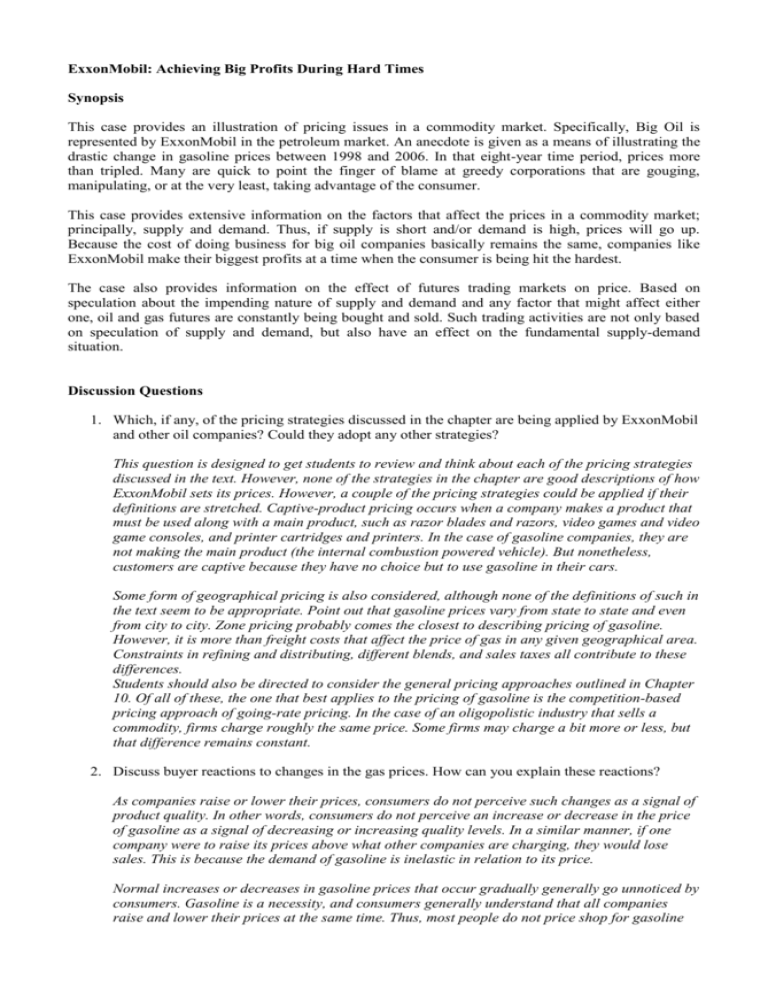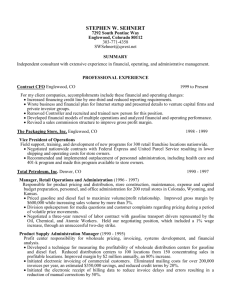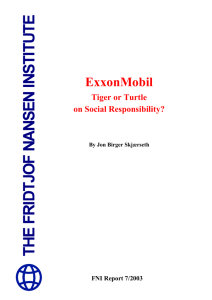ExxonMobil: Achieving Big Profits During Hard Times
advertisement

ExxonMobil: Achieving Big Profits During Hard Times Synopsis This case provides an illustration of pricing issues in a commodity market. Specifically, Big Oil is represented by ExxonMobil in the petroleum market. An anecdote is given as a means of illustrating the drastic change in gasoline prices between 1998 and 2006. In that eight-year time period, prices more than tripled. Many are quick to point the finger of blame at greedy corporations that are gouging, manipulating, or at the very least, taking advantage of the consumer. This case provides extensive information on the factors that affect the prices in a commodity market; principally, supply and demand. Thus, if supply is short and/or demand is high, prices will go up. Because the cost of doing business for big oil companies basically remains the same, companies like ExxonMobil make their biggest profits at a time when the consumer is being hit the hardest. The case also provides information on the effect of futures trading markets on price. Based on speculation about the impending nature of supply and demand and any factor that might affect either one, oil and gas futures are constantly being bought and sold. Such trading activities are not only based on speculation of supply and demand, but also have an effect on the fundamental supply-demand situation. Discussion Questions 1. Which, if any, of the pricing strategies discussed in the chapter are being applied by ExxonMobil and other oil companies? Could they adopt any other strategies? This question is designed to get students to review and think about each of the pricing strategies discussed in the text. However, none of the strategies in the chapter are good descriptions of how ExxonMobil sets its prices. However, a couple of the pricing strategies could be applied if their definitions are stretched. Captive-product pricing occurs when a company makes a product that must be used along with a main product, such as razor blades and razors, video games and video game consoles, and printer cartridges and printers. In the case of gasoline companies, they are not making the main product (the internal combustion powered vehicle). But nonetheless, customers are captive because they have no choice but to use gasoline in their cars. Some form of geographical pricing is also considered, although none of the definitions of such in the text seem to be appropriate. Point out that gasoline prices vary from state to state and even from city to city. Zone pricing probably comes the closest to describing pricing of gasoline. However, it is more than freight costs that affect the price of gas in any given geographical area. Constraints in refining and distributing, different blends, and sales taxes all contribute to these differences. Students should also be directed to consider the general pricing approaches outlined in Chapter 10. Of all of these, the one that best applies to the pricing of gasoline is the competition-based pricing approach of going-rate pricing. In the case of an oligopolistic industry that sells a commodity, firms charge roughly the same price. Some firms may charge a bit more or less, but that difference remains constant. 2. Discuss buyer reactions to changes in the gas prices. How can you explain these reactions? As companies raise or lower their prices, consumers do not perceive such changes as a signal of product quality. In other words, consumers do not perceive an increase or decrease in the price of gasoline as a signal of decreasing or increasing quality levels. In a similar manner, if one company were to raise its prices above what other companies are charging, they would lose sales. This is because the demand of gasoline is inelastic in relation to its price. Normal increases or decreases in gasoline prices that occur gradually generally go unnoticed by consumers. Gasoline is a necessity, and consumers generally understand that all companies raise and lower their prices at the same time. Thus, most people do not price shop for gasoline and in general, do not pay much attention to the price of gas. But rapid and drastic price fluctuations are those that grab consumers’ attention. 3. How should ExxonMobil react to gasoline price changes by other large and small oil companies? Can ExxonMobil keep its prices stable (or even lower them) when the market price is increasing? Should it? Because ExxonMobil follows a going-rate strategy that is based on the supply-demand governed market price, this is more of a hypothetical question. This question is also meant to incite somewhat of an ethical discussion regarding an issue that many students undoubtedly have thought about. While ExxonMobil is simply setting price according to market, are they bound to do so? Can’t they lower their prices if they want to? One point-of-view will say that at times of high prices when ExxonMobil and other companies are making huge profits, they should give customers a break and lower prices. They can afford to, after all. The other point-of-view will say that ExxonMobil is not doing anything wrong; it is simply conducting business. Therefore, it has every right to charge market rates. In fact, as far as ethics are concerned, some might point out that it is ExxonMobil’s duty to reap high profits when they can because they have a moral obligation to investors with respect to stock price. Also, no one feels sorry for the big oil companies when excess supply drives prices down (as was the case in the late 1990s) and their profits are low. Periods of high gas prices allow oil companies to make up lost profits from those periods. One other point that should be brought up here is ExxonMobil’s margin. As the case points out, the entire oil industry had a profit margin of only 8.5 percent in 2005. So, why did oil companies make record profits in that year? The simple reason of scale: they sell more volume of their product than any other industry. Thus, even if ExxonMobil wanted to cut prices artificially and give customers a break, just how big of a break could they give? If they were to cut their margin by 2 percent or 3 percent, at $3 a gallon, that would amount to only 6-9 cents per gallon. 4. Consider the public policy issues within and across channel levels of the oil industry. Is ExxonMobil acting illegally or irresponsibly by reaping record profits while consumers are hurting at the pumps? It should be very clear after reading this case that the big oil companies are not violating pricefixing laws. Even after various government investigations, there is no evidence of such. So, unless one wants to subscribe to an extreme conspiracy theory that the government officials and agencies conducting such investigations are being paid off, this argument does not hold water. Additionally, there is the evidence that oil companies sell a commodity, and by definition, all companies follow going-rate price. In a similar manner, there is no evidence of the issues of pricing across channel levels such as price discrimination, retail price maintenance, or deceptive pricing. This, combined with the answer to question 3, would indicate that ExxonMobil has not acted irresponsibly. 5. How would you “fix” the problem of rising gas prices? Consider solutions for different groups, including governments, corporations, and consumers. What are the advantages and disadvantages of your proposed solutions? Governments: At times of high gas prices, consumers point to politicians for answers and for relief. Thus, in times of elections cycles, gas price seems to be somewhat of a campaign issue. Some of the following are options: Place artificial limits on the profits that gasoline companies can make. This, however, would interfere with a free-market economy and have repercussions on other aspects of the industry as well as the economy. As the answer to question 3 points out, such limits would likely not help much in the way of reducing the price of a gallon of gas for individuals. Reduce gasoline sales taxes. Given that gasoline sales taxes averaged 40 cents a gallon in 2005, it would seem that more relief could be given to consumers by reducing such than by limiting the profits of oil companies. Could federal and state governments cut that tax in half? It would be a start. But where does that tax money go? Generally speaking, it pays the bills on roads and government transportation costs. Thus, if this revenue is lost, either those areas will suffer, or the revenue will have to come from somewhere else. Passing legislation that would increase the production and refining capacities of oil and gas in the United States. It would seem that this is the area where the government could have the biggest impact. The government would not even have to subsidize such activities. It would simply have to make it possible for oil companies to build more refineries, pipelines, and drilling operations. This would not only increase supply and reduce price, but it would allow the United States to be less dependent on foreign oil. The downside to this is the effect of such operations on the environment. Corporations: To help the supply-demand equilibrium, big oil companies could optimize their efficiency for producing and refining within the constraints set for them. They could also invest in the development of alternative fuels such as ethanol. And yet, as the production and use of such an alternative would bring down the demand for petroleum-based fuels and lower the price of such, it is not clear that the pricing for alternative fuels would make it possible for this shift to take place (i.e., if ethanol is more expensive and results in lower fuel economy, why would consumers buy it?). Consumers: The biggest thing that consumers could do to help gas prices is to buy less. While that may sound counterintuitive, less consumption means less demand and that means lower prices in a commodity market. However, consumers in the United States are very slow to make the kinds of behavioral modifications that have a significant impact on gas consumption. Carpooling, using public transportation, and simply cutting back on how much driving is done are all things that most consumers are reluctant to do unless driven to an extreme. Even the act of switching to more fuel efficient vehicles is something that is relatively slow to occur. Consumers want cheaper fuel, but do not want to be inconvenienced.








